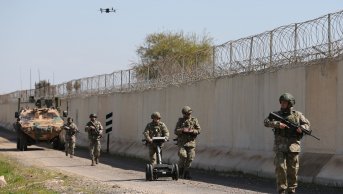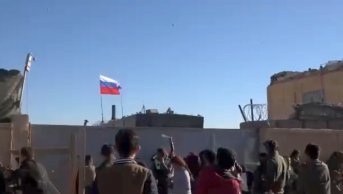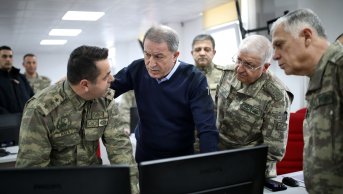The Causes and Possible Results of the Fighting in Bayır Bucak
The Syrian Turkmens are among these groups which were most affected by the Syrian civil war. The main reasons for that are their geographically dispersed settlements, their weak organization in social, political and military terms, their organized and militarily powerful neighbors, the low Turkmen population, the lack of foreign support other than that of Turkey and the differing strategic character of their regions with respect to various actors.
No clear information on the Syrian Turkmens’ population is present. According to them, most Turkmens lost their language and identity, therefore Arabicised. Yet, those Turkmens who preserved their language and identity are reported to have a population ranging from several hundred thousand to 1.5 million. Even though they are dispersed in the country, they are concentrated in the rural areas of Aleppo and Latakia near the Turkish border.
The Syrian Turkmens have sided with the Free Syrian Army (FSA) since the beginning of the uprising. Yet, FSA is weak in the multilateral struggle in Syria as of the current situation. On the contrary, along the Turkish-Syrian border where Turkmens live, ISIS terrorists, Kurdish militia YPG and the Russia-backed regime gain increasing power.
The Syrian regime is likely aware that they will no longer be able to maintain control in the whole of Syria. It seeks to create a “regime zone” in highly populated, strategically important regions, which have access to the sea and is populated with people loyal to it. Russia seems to have been involved in the civil war in order to support the regime with this objective. Likewise, its air operations serve to expand the regime’s territory, ensure safety in its surroundings by terminating proximate threats and force the “beleaguered” people to relocate.
The planned regime zone includes the provinces Latakia, Damascus and Tartous and the western portions of Hama and Homs. The district of Bayır Bucak in the Latakia province, where Turkmens majorly live, is one of the biggest hurdles in front of the planned regime zone. The people living here have supported the uprising from its onset and started to govern their own territory after the middle of 2012. Many of those Turkmens were forced to relocate to Turkey after heavy air bombardments.
Bayır Bucak is very important for Turkey. Above all, the region stands at Turkey’s border; hence it is important for border security in such an environment where the central authority does not exist. It is also vital for Turkey’s policy to weaken the Assad regime and support the opposition. The fall of Bayır Bucak is likely to pave the way for the shift of the military balance in Idlib and Aleppo in favor of the Syrian regime. It is also instrumental for keeping the Assad regime away from the border and severing its geographical link to Turkey. Beside the political and strategic reasons, the single fact that Turkmens live in the district makes Bayır Bucak valuable for Turkey. The Bayır Bucak Turkmens are descendents of the Karamanoglu tribe of Turkmens and they were moved to Syria from the Middle Anatolia and Mediterranean regions during the Ottoman era. Therefore, the Bayır Bucak Turkmens have a lot of relatives in Turkey.
What makes Bayır Bucak important for all involved actors is the fact that who controls Bayır Bucak gains access to the Mediterranean Sea. If the Syrian opposition has this advantage, they will be able to receive support more smoothly. Access to the sea will secure the success of Syrian opposition, particularly in the northern front. Yet, Bayır Bucak is also important for the Kurds. Although it is difficult to conceive as of the current situation, the long term goal of the Kurdish militia force YPG is to ensure the Kurdish regions’ access to the sea. Bayır Bucak is the only place that Kurds can reach the sea. Yet, the Assad regime’s presence rather than Turkmens near the sea in Bayır Bucak is the biggest hurdle in front of the Kurds. Though, if the circumstances change in the long term and the Turkmens in Bayır Bucak is annihilated, YPG might secure its access to the sea through its alliance with the Assad regime and Russia.
Despite the importance of Bayır Bucak, the Assad forces have been unable to capture the district for three and a half years. The opposition enjoyed various advantages, since the fighters from the local population knew the area very well. Besides, Turkey’s rules of engagement had resulted in de facto no fly zones near the border line. The Syrian air force had limited capacity to carry out operations. However, Russia’s intervention in Syria has brought about a new balance of power. Russia’s military capacity and deterrence enabled the Assad regime to initiate air operations against Bayır Bucak.
Given the importance of Bayır Bucak and the new military balance, the Syrian army, Hizbullah and foreign fighters initiated an operation toward Bayır Bucak with the Russian air support in the third week of November. In the first five days of the fighting, the regime forces have conducted a fast advance under the intense Russian air cover. Turkmens retreated from Fırınlık, Gımam, Acısu, Tebet Izar, Kızıldağ and Bayındır. Almost eighty percent of the Turkmen mountain was captured by the regime. Among these, Kızıldağ has a strategic significance. Whoever controls Kızıldağ is able to control the surrounding 17 villages as well. Yet, at the end of the fifth day Turkmens were able to recapture Kızıldağ with the help they received from Idlib. Fighters from the Sultan Abdulhamid Brigade and the Cebeli Islam captured a significant portion of Kızıldağ. Similarly, the regime was forced to withdraw from several places in Fırınlık. The reason of the support that Turkmens received from Idlib is that after Bayır Bucak falls, the regime will target Idlib next. With the capture of Idlib by the opposition, the pressure over Latakia increased. The opposition even conducted operations in Kırdaha, the original home of the Assad family. It is likely that the regime and Russia will seek to secure Bayır Bucak and then move to Idlib. The opposition groups in Idlib supported Bayır Bucak to reinforce their defensive lines. Therefore, the opposition forces stopped withdrawing and even made some gains in several places.
Meanwhile, an important development that can influence the course of the fighting in Bayır Bucak took place. Turkish fighter jets downed a Russian aircraft supporting the operations in Bayır Bucak on the grounds that it had violated Turkish airspace. Russia’s violations of Turkish airspace started in October when Russia’s involvement in Syria began. It was declared that these violations were unintentional. However, it is obvious that that the violations and sorties along the border serve a different purpose, as shown by the latest developments. Above all, Russia wanted to terminate the de facto no fly zone that Turkey had established along the border via its rules of engagement. The major reason for the inability of the Assad regime to capture Bayır Bucak was that it could not conduct air operations near the border because of Turkey’s rules of engagement. Previously, two Syrian helicopters flying over Bayır Bucak was shot down by Turkish jets. Russia wanted to tell Turkey through its airspace violations that it is present in the region and all actors must behave accordingly. Therefore, it wanted to create a new military situation on the ground that will allow air support for operations along the border. Besides, it is also possible that it wanted to test Turkey’s response to a violation.
Turkey’s downing of Russian jet will likely create repercussions for the fighting in Bayır Bucak as well as the bilateral relations. Turkey’s move will limit the air operations of Russia in Bayır Bucak, since it is difficult to conduct operation along the border line without airspace violation. Therefore, it will affect the balance of power in the region in favor of the Turkmens and the opposition. Nevertheless, the downing of the aircraft will likely push Russia towards conducting more operations rather than deterring. First statements from Russia tend towards escalating the crisis. Russia may choose to be careful about airspace violations but is more likely act aggressively against Turkey’s strategic interests. It will bring about more operations against Bayır Bucak, Turkmens and the opposition and more support for the Assad regime and PYD/YPG. In addition, Turkish-American joint air operations against the ISIS in Azaz-Jarablus region will be more perilous. Russia will be looking out for any opportunities that will enable a response against Turkey. The biggest risk is that Russia may target Turkish jets that conduct air operations in against ISIS the Syrian airspace over Azaz and Jarablus. Russia could jeopardize Turkey’s safe zone plan and push PYD/YPG to move towards the planned safe zone.
Another important risk for Turkey related to the fighting in Bayır Bucak is new migration waves. Bayır Bucak is under the control of local people’s milita forces for three and a half years. Yet, the area has never been totally safe. Its mountainous terrain is unsuitable for military operations; therefore the opposition has managed to maintain control. The Syrian army has subjected the region to constant artillery and aerial bombardment. A significant portion of the local population has taken shelter in Turkey. They live in the Yayladağı camp and go to Syria on a daily basis to keep track of their business and estates. In addition, there are a large number of people, who did not abandon their houses. Russian air bombardment will likely cause the civilians to evacuate the district and migrate to Turkey, while at the same time those civilians living in Turkish camps will no longer be able to return to their homes.
The fall of Bayır Bucak and the expulsion of the local Turkmens bring about the extermination of the Turkmen presence in Syria. The Golan Turkmens was forced to migrate when Israel invaded the Golan Heights in 1967. Most of them currently live in Damascus. The Homs Turkmens in both urban and rural areas had to abandon their homes when the civil war started. Zara, the largest Turkmen town in Homs, was permanently destroyed by the Assad regime. The Turkmens of Zara migrated to Akkar and Baalbek, taking shelter near their relatives. The Raqqa Turkmens was forced out of their homes after YPG captured Tel Abyad and escaped to Turkey. Amnesty International published a report that includes satellite images detailing the destruction of settlements by YPG. The northern side of rural Aleppo, which housed the most of the Syrian Turkmens, is under the invasion of the ISIS. Most people that lived in the area between Azaz and Jarablus had to escape to Turkey. Therefore, Bayır Bucak is the last territory of the Turkmens in Syria. If Mount Turkmen is lost, the Syrian Turkmen presence will be permanently destroyed. However, any success to be gained here will motivate and encourage Turkmens for unity and nationalism. Such a progress will contribute to the efforts for liberating the Turkmen villages situated in the north of Aleppo and in the area between Azaz and Jarablus.










